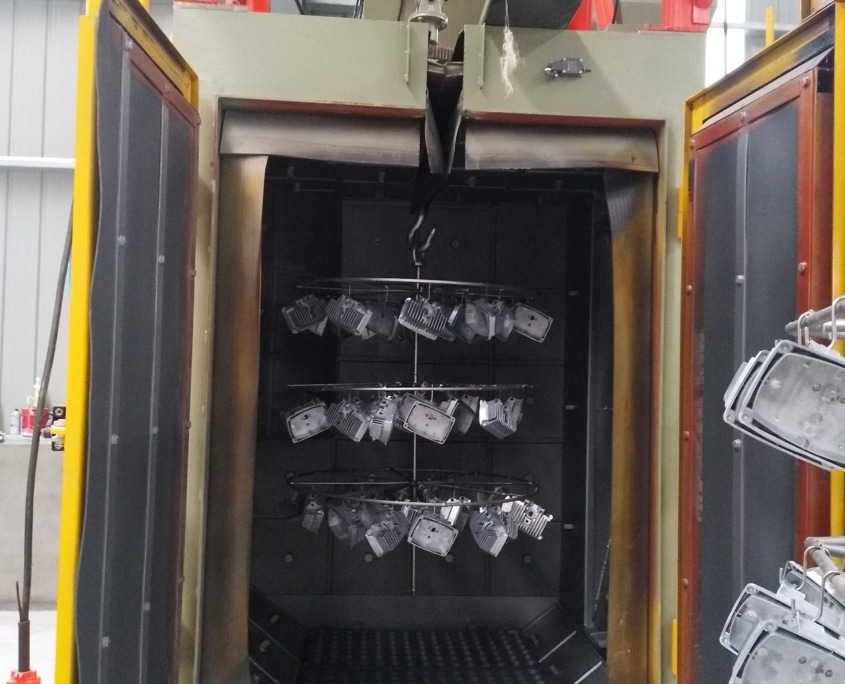What is Shot Blasting?
After a factory produces a part, it undergoes a final process before finishing, known as pre-finishing. During pre-finishing, the part’s surface is cleaned and primed for painting or drilling. The primary means of cleaning the surface is through shot blasting.
Despite its name resembling sand blasting, shot blasting is vastly different in terms of surface treatment and cleaning. Shot blasting is a highly aggressive method for surface treatment that is typically used on larger and tougher surfaces.
In essence, shot blasting involves propelling “shots” onto a surface that needs to be cleaned using an industrial machine powered by centrifugal or mechanical force. Unlike traditional methods that use pressurized air, shot blasting uses a spinning wheel to hasten the delivery of the selected abrasive.
Technologies of Shot Blasting
While the surface treatment industry has a variety of available technologies, shot blasting mainly employs two abrasive delivery methods.
Wheel blasting was first carried out using air for abrasive delivery. However, spinning wheels were later employed to maximize efficiency and output power. These wheels were designed with centrifugal force in mind and could disperse a greater amount of abrasive over an exposed surface.
The typical speed of a Shot Blasting machine ranges from 65 to 110 meters/second. Moreover, the dispersal area was spacious enough to ensure uniform cleaning or treatment of a surface. From 60 kg/min to nearly 1200 kg/min, the amount of abrasive delivered quickly not only cleaned the surface but also did it efficiently. Therefore, wheel blasting is a preferred method for large-scale work.
While wheel blasting requires minimal power, air blasting is a power guzzler. Air blasting is still utilized in certain sectors as it was the initial form of the shot blasting process.
This method of abrasive delivery is akin to sand blasting, where compressed air propels shots onto targeted surfaces. However, the limitations of this process become apparent when larger forces are required. For the same amount of abrasive delivery, air blasting requires 16 times more horsepower than wheel blasting.
Additionally, the number of workers required to operate a high-powered air blasting machine is exponentially larger compared to the two workers needed to safely operate a wheel blasting machine.
Process of Cleaning in an Industrial Shot Blasting Machine
When manufacturing a metal or non-metal part in a factory, it does not emerge as the shiny, polished product seen in showrooms or retail shops. Prior to achieving that final appearance, it is vital to remove all oxides, uneven surfaces, and other impurities from the surface of the part.
Performing this process by hand is neither efficient nor safe. This is where shot blasting machines are used in many manufacturing plants. These machines are large, highly efficient, safe, and user-friendly. Here are the steps involved in pre-finishing a part using a shot blasting machine.
So, Sandblasting or Shot Blasting, What Should You Use?
Well, the answer to that question depends on your specific needs. If you have small parts, sandblasting can be a cost-effective approach, as can shot blasting for large quantities.
However, industrial operations often find shot blasting more economical as it processes components of varying sizes. Sandblasting, meanwhile, is a technology worth considering for its portability and relative ease of use.
Eurobalt® for Your Shot Blasting Needs?
You have the option of choosing between sandblasting and shot blasting, depending on your needs. Eurobalt Engineering provides both possibilities to meet your production requirements. You can select either option for machined, cast, or sintered parts, and our team of skilled workers will complete the job.
Our factories are equipped with both sand and shot blasting machines, so simply inform us of what you require for the production of your goods and we will handle the rest, including surface cleaning. We offer pre-finishing services and also provide powder coating to give your parts the desired look and protection.



